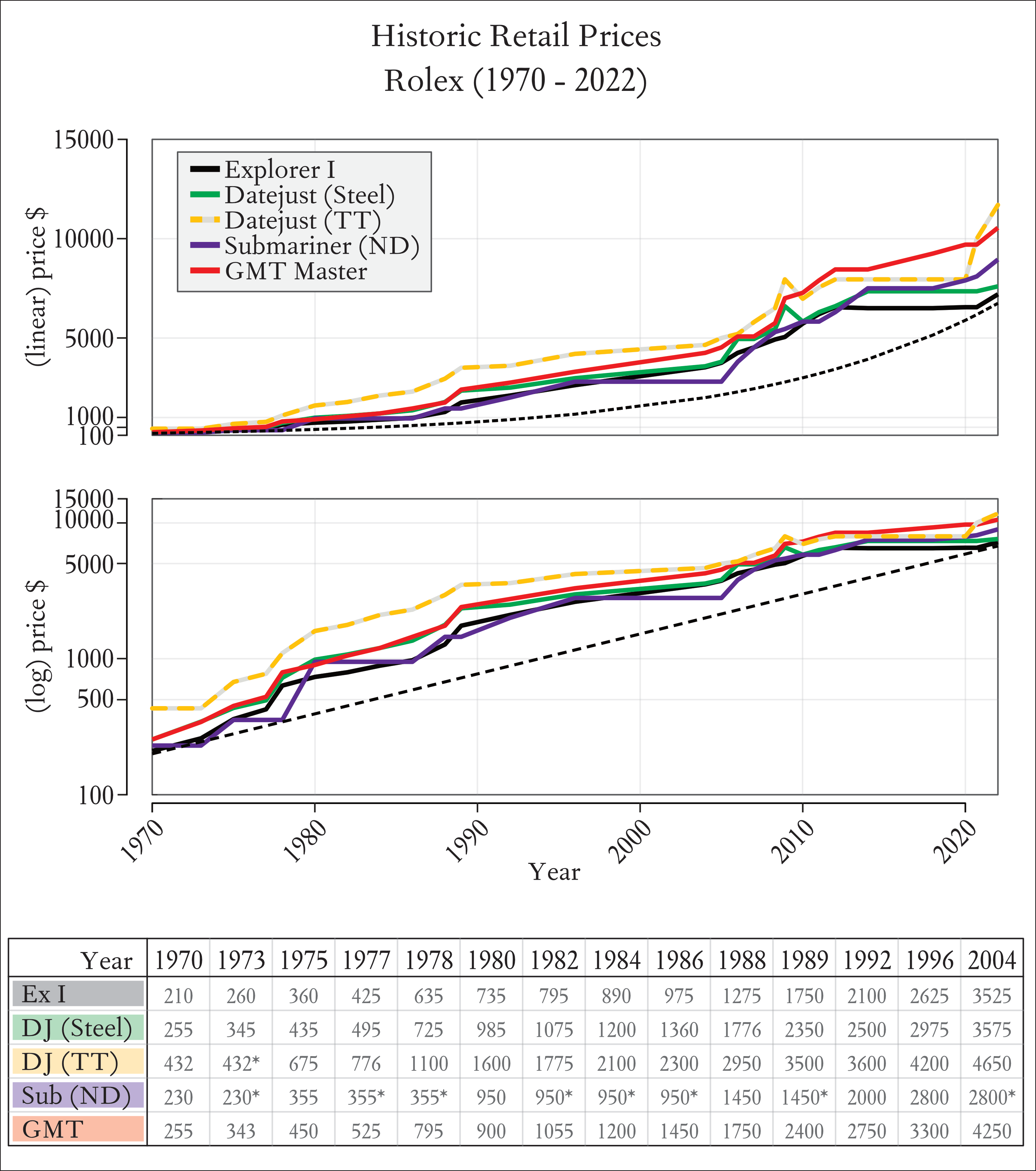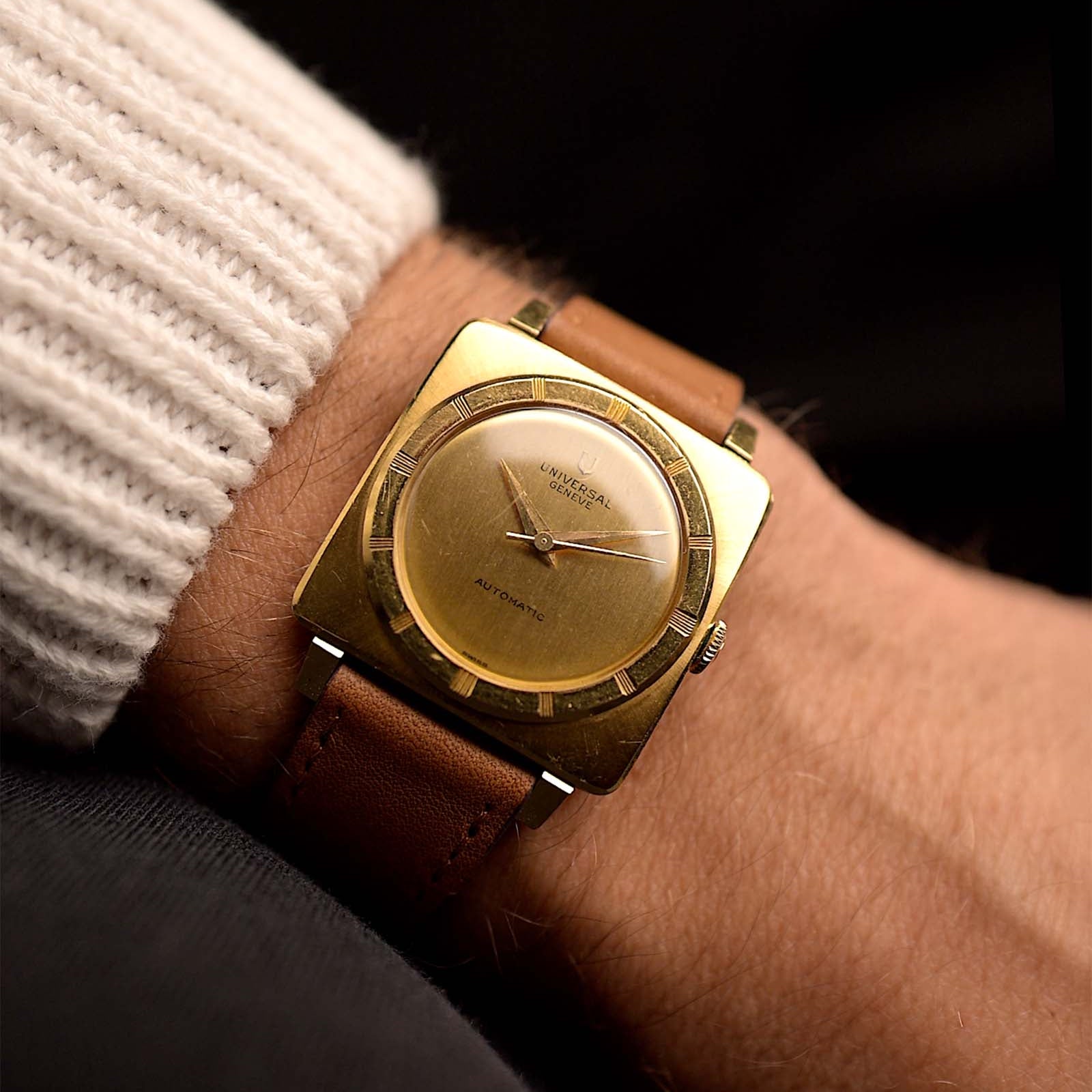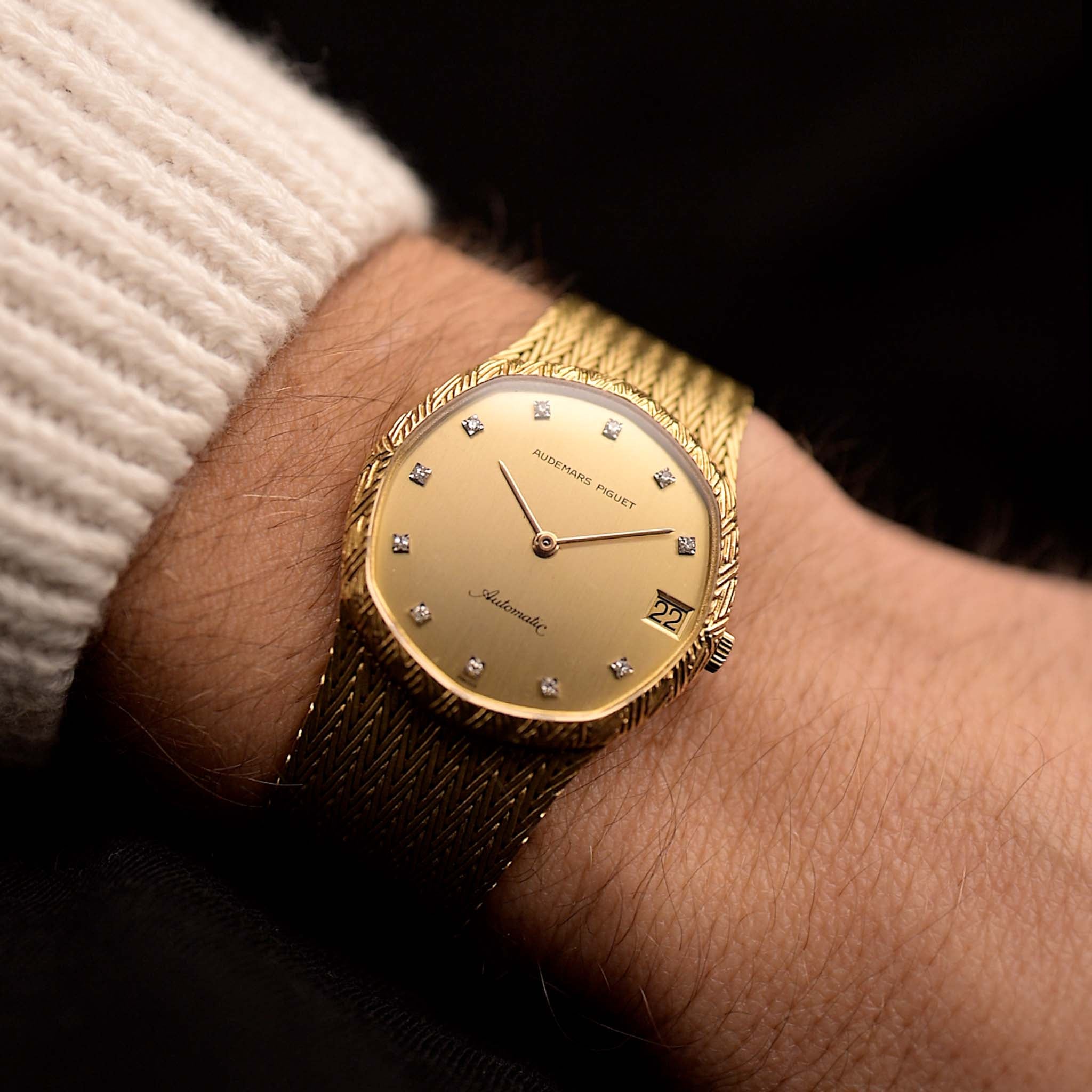Secretly we all thought at some point: "If I'd have a time-machine, I'd go back and buy the complete Rolex stock". Because things used to be cheaper in the good old days... right? So let's sport that idea further and find out how much you'd really have to give up to buy yourself a brand-new Rolex in the 1970s, 80s or 90s. Gentlemen and Gentlegirls start your flux-compensators, we're in for a wild ride!
June 21, 2022
The Historic Value of Rolex Watches

Marcus Siems @siemswatches
Collector, Author, Data Analyst
Let me start with the conclusion this time; because when the topic comes to money in our horological world it tends to sound very elitist very soon. However, what we shall never forget is that there are many forms of value. Monetary is just one, and possibly the most profane, whereas sentimental, personal, historical value are the things that matter a lot more (imho). Watches are not a necessity at all and the decision to get yourself such a luxury item is for the average person always very deliberate. If you're passionate about something go for it and don't look what the IG account next to you got. You do you. And let us know in the comments how you feel about this topic.
Secretly we all thought at some point in our collecting journey: "If I'd have a time-machine... I'd go back and buy the complete Rolex stock", or "I just get that full-set Paul Newman Daytona from a 1990s auction". A watch enthusiast can dream... And it's probably the one way of cheating we allow ourselves to go after. In this article, you will learn how much Rolex watches are worth over the years including Rolex price charts.
 Forget about the numbers Part I: Follow your eye and discover the endless simplicity of this white 1990s Rolex Datejust dial... That detailed minute track and the eccentric almost hidden roman numerals. Forget about the numbers... Photo @goldammer.me
Forget about the numbers Part I: Follow your eye and discover the endless simplicity of this white 1990s Rolex Datejust dial... That detailed minute track and the eccentric almost hidden roman numerals. Forget about the numbers... Photo @goldammer.me
In 1970 a Rolex Submariner 5513 cost about 230$[1]... quite a bargain from todays perspective but of course that's not the (monetary) value equivalent. 200$ today are not the same as 200$ in 1970, 80, or 90 - there's inflation and other factors. But then comes the question: who could afford such a watch historically? How much of your salary did you have to give for your very own brand-new Rolex watch?
 Figure 1. Historical retail price evolution of the most common Rolex collections - Explorer I, Datejust steel, Datejust two-tone, Submariner (no-date) & GMT-Master. All prices are in US Dollar. The asterisk indicate low estimates due to missing values. The references do change over time - see the full list via the link[1].
Figure 1. Historical retail price evolution of the most common Rolex collections - Explorer I, Datejust steel, Datejust two-tone, Submariner (no-date) & GMT-Master. All prices are in US Dollar. The asterisk indicate low estimates due to missing values. The references do change over time - see the full list via the link[1].
Discover our available Vintage Watches Collection >
Let's first look at the "raw" retail prices[1]. Over the last 50 years prices have increased from a couple hundred to a couple thousand bucks and the increases seem to speed up recently and particularly in the 2000s.
But if there's one thing we should have learned from the recent pandemic then it's that humans are not wired to intuitively understand exponential growth. If you have a constant price increase of let's say 7% per year (black dashed line) this would look very sped up in later years but still linear on a logarithmic scale (the lower plot). In other words the multiplicative increase is constant (#sorryNotSorry for the math lecture).
 Forget about the numbers Part II: What adds more light to your soul than seeing the beauty of this transitional Rolex Datejust 1608. The warm and cozy embrace of the gold on gold pie-pan dial, the perfect shape of the dagger hour markers and the dauphine hands... It just lures me in, let's me forget about the numbers. Photo @goldammer.me
Forget about the numbers Part II: What adds more light to your soul than seeing the beauty of this transitional Rolex Datejust 1608. The warm and cozy embrace of the gold on gold pie-pan dial, the perfect shape of the dagger hour markers and the dauphine hands... It just lures me in, let's me forget about the numbers. Photo @goldammer.me
So from this multiplicative standpoint Rolex did actually increase their retail prices most between 1980-2000. But again, those are mere "prices". There's a reason this article's headline features the phrase "Historic Value". The absolute prices don't tell too much about the historic context, it's about what those numbers meant for the people at the time. So the next step is to look at the "inflation-corrected" prices. Basically, what's the money from back then approximately worth today[2]?
 Figure 2. Historical retail price for the Rolex Datejust (solid line) plotted against the inflation corrected prices (dashed line)[6].
Figure 2. Historical retail price for the Rolex Datejust (solid line) plotted against the inflation corrected prices (dashed line)[6].
We are looking for now at the classic Rolex Datejust in steel - a true workhorse from the brand. If Rolex did increase their prices solely in response to inflation, the relative (monetary) value would be constant over time (dashed line). However, we see that even corrected prices also increase over the last 50 years.
 Forget about the numbers Part III: It's not only blue eyes that make you sink in... a blue dial can very much have the same effect. What a dreamy Rolex Airking this is... and yes, you don't always need the date window - forget about those numbers. Photo @goldammer.me
Forget about the numbers Part III: It's not only blue eyes that make you sink in... a blue dial can very much have the same effect. What a dreamy Rolex Airking this is... and yes, you don't always need the date window - forget about those numbers. Photo @goldammer.me
This only means that there's more than inflation going into the retail prices over at Rolex (average inflation rate since 1970 is around 3.9%, around 2% for the last ~30 years[2]). And this makes some sense as the watches have also been updated and upgraded all throughout the years. In 1977 for example the Datejust movement was overhauled to the Caliber 3035[3-5] and consequently we see a spike in value increase. New Caliber 3135 and adding a sapphire crystal in 1988[4] - boom! another spike. So the "value"-evolution is clearly mirroring the technical evolution as well.
But one question still remains: how much of your salary would you have to give to (historically) own your very own Rolex watch? We did see that inflation is one factor but your salaries can still vary in relation to the inflation rate. So let's have a look at how much of your household income you would have had to spend on your new Rolex?
 Figure 3. Historical Price Evolution of the Rolex Datejust relative to the average (Median, thin line) Annual Household Income and the upper 10% (90th-percentile, thick line) Annual Household Income[6].
Figure 3. Historical Price Evolution of the Rolex Datejust relative to the average (Median, thin line) Annual Household Income and the upper 10% (90th-percentile, thick line) Annual Household Income[6].
Well the average American household wouldn't have to give their last pair of shoes to own their Datejust but still a quite substantial amount. Since the new series and the subsequent increase in 1988 you'd have to spend more than one month salary! Very substantial actually. It seems to have become less and less affordable for the average (American) person to buy a new Rolex. When we take into account that the (inflation corrected) median household income has been quite stable over the last 50 years[6], such a relative increase ultimately makes a lot of sense.
But let's be frank, Rolex watches are a high-level grown-up toy and nothing you'd have to have. It's something extra for yourself, a luxury item. And luxury tends to rather not be targeted towards the average but the upper income households. So what about the people who have a little more extra to spend? Looking at the percentage a household in the upper 10% would have to give up for a brand-new Rolex Datejust we see a quite different picture.
 Forget about the numbers Part IV: Speaking about luxury... sometimes sparkling wine is just not right, Champagne is what you're looking for. Just like a Champagne dial... Anyone else feeling the extravaganza? Photo @goldammer.me
Forget about the numbers Part IV: Speaking about luxury... sometimes sparkling wine is just not right, Champagne is what you're looking for. Just like a Champagne dial... Anyone else feeling the extravaganza? Photo @goldammer.me
The upper 10% income does actually increase - even when corrected for inflation - over the last 50 years[6]. And a luxury brand like Rolex can very well target this group and adapt its prices accordingly. Looking after the inflection points around 1977 and 1988 we do actually see that the relative value decreases again until the next innovation period starts. Again, it's technical developments that seem to fuel the retail prices most.
 Forget about the numbers Part V: Come, come a little closer. Do you see what I see? This amazing Rolex 1505 with its unique bezel. The patina of this two-toned beauty is something no money can buy. It's made with time, so forget about the numbers. Photo @goldammer.me
Forget about the numbers Part V: Come, come a little closer. Do you see what I see? This amazing Rolex 1505 with its unique bezel. The patina of this two-toned beauty is something no money can buy. It's made with time, so forget about the numbers. Photo @goldammer.me
So conclusively, what can we make out of all of this? Let's start that the world of - particularly vintage - watches is gladly mostly driven by enthusiasm and passion! Big corporate, just like Rolex, has to think about maximizing their margin, it's not about the average Joe. We have to face that. I don't want to bash Rolex or any other brand here, it is simply that technological evolution and economic growth comes at a price, too. You can't expect to get a better and better product but still pay the same.
On the bright side, we are all "invested" in a hobby in which value transcends money. In the credo of Cole Pennington - "always read the caseback" - watches can through engravings and personalization become unique and potentially historically relevant. The watches you wear when your kids are born, while you are on vacation or during an important presentation become sentimentally important. All things that are far more valuable than the "resale price".
 Forget about the numbers Part VI: They say it's always the same yet there's so much variation in the details... The Datejust has traversed through so many design revolutions, it might be only the dial yet it completely changes the face of the watch. The Buckley they call it, the Roman Numerals are the numbers that dissociate this piece oh so well. Photo @goldammer.me
Forget about the numbers Part VI: They say it's always the same yet there's so much variation in the details... The Datejust has traversed through so many design revolutions, it might be only the dial yet it completely changes the face of the watch. The Buckley they call it, the Roman Numerals are the numbers that dissociate this piece oh so well. Photo @goldammer.me
If I learned one thing during my collecting journey it's that "not being able" to get something makes you think a lot harder about what you truly want. Maybe the historic value of Rolex (and other luxury brands) watches is exactly that - showing us what we really need?
I enjoy simply looking at watches, test-wearing one from time to time... I don't need to own every single piece I like. You also don't need to hang every painting you see in a museum into your living room. In the same way you don't have to put every watch you see on Instagram into your watch box. As in another sentiment: There is the right partner for you, so there also will be the right watch for all of us. And the good news is that this seems to have been true for at least the last 50 years. Let's embrace that!
 Forget about the numbers Part VII: A stunning 1970s Rolex Datejust 1601. A stainless steel watch with a silver dial. Some might say it's too plain, even boring. I'd beg to differ! It's always about the details. It's about the sunburst dial, with the pie-pan step to the edge. The unique yellowish-orange patina on the lume. The play of light with the bezel, the Jubilee bracelet and the different metals from steel to white gold and the various finishing techniques. Photo @goldammer.me
Forget about the numbers Part VII: A stunning 1970s Rolex Datejust 1601. A stainless steel watch with a silver dial. Some might say it's too plain, even boring. I'd beg to differ! It's always about the details. It's about the sunburst dial, with the pie-pan step to the edge. The unique yellowish-orange patina on the lume. The play of light with the bezel, the Jubilee bracelet and the different metals from steel to white gold and the various finishing techniques. Photo @goldammer.me
Another good thing is that we can also list a few alternatives here... First, it does not always have to be a brand new Rolex watch. You can always go vintage and discover something beyond steel sports models and the "Hype". Second, by now there's a myriad of manufacturers who are taking the democratization of beautiful and high-quality watches seriously. Take for example the stunning craftsmanship over at Kurono Tokyo, the modern-go-vintage pieces at Furlan Marri or Dan Henry, street style meets watches with the Rowing Blazers x Seiko collab and the extravagant M.A.D.1 by MB & F to name only a few. (There's no affiliation to any of these brands)
Disclaimer: This analysis does of course miss many points and shouldn't be taken too seriously - outside (hopefully) the entertainment factor. I'm not even an economist, just a bloke who knows how to crunch numbers a bit. For example: There are more households today as there have been 50 years ago, and there's (on average) a lot less children within these households, to just name a few points. Still I hope you enjoyed it, learned a little and might wanna check out more of our stories.
Discover our available Vintage Watches Collection >
References
[1] Rolex Price Evolution; Minu4Plus6;
https://www.minus4plus6.com/PriceEvolution
[2] Inflation Calculator; Dollar Times;
https://www.dollartimes.com/inflation/
[3] The History of the Rolex Datejust; Caitlyn Bazemore, Crown & Caliber;
https://blog.crownandcaliber.com/the-history-of-the-rolex-datejust/
[4] Rolex DateJust History; Bob's Watches;
https://www.bobswatches.com/watch-resources/rolex-datejust-history
[5] Rolex Datejust - History & Design; Felix Goldammer, Goldammer Vintage Watches;
https://www.youtube.com/watch?v=pY4_cta-Kio
[6] Household Income by Year; DQYDJ;
https://dqydj.com/household-income-by-year/
All rights on text and graphics reserved to the Author.




























Leave a comment